Copyright 2020 - 2021 irantour.tours all right reserved
Designed by Behsazanhost
Isfahan: One-day free city tour program
Isfahan: One-day free city tour program
Isfahan is the most important and beautiful tourist destination and the obsession of all travelers. This beautiful historic city with the most beautiful architectural monuments and hospitable people grabs the hearts of the tourists. So a trip to Iran without Isfahan or Persian Florence would not be complete. The beauty of Isfahan is not limited to its historical monuments, the local culture, artworks, crafts, souvenirs, and fine restaurants with traditional and international cuisine will have you stay for many days. You can spend days and days in Isfahan visiting all the historical sites and natural beauties. Our daily tours can help you to discover Isfahan well.
But if you have limited time, one of our suggestions will help you to discover it easily.
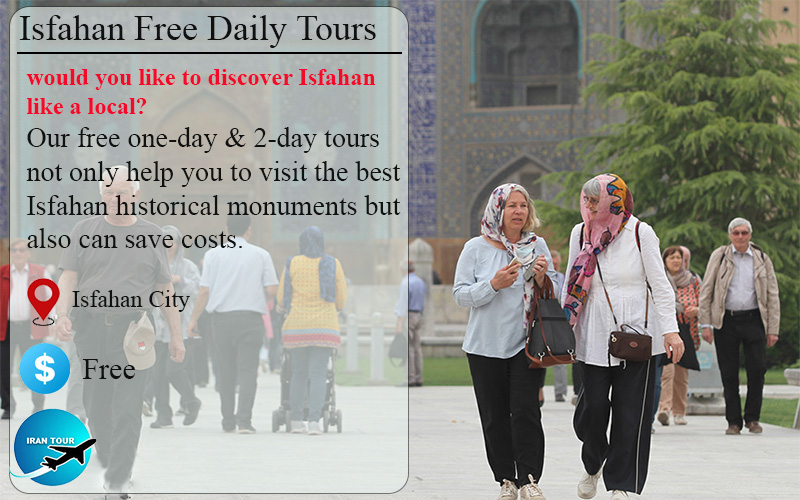 |
One-day city tour program.
In this one-day
5-star Hotels: Abbassi Hotel.
4-star Hotels: Safir Hotel
3-star Hotels: Venous, Avin, Setare(Star), Partikan and Malek Hotels.
This historic route includes the most beautiful Safavid palaces (Eight Paradise or Hasht Behesht and Chehel Sotoon or "40 columns") the most spectacular mosques (Imam and Sheikh Lotfollah Mosques) and the most prominent royal Palace Ali Qapu. Finally, the Qeysarie Bazaar or Soltani Bazar will embrace you with different artistic workshops. Isfahan's historic heart is your selected route.
We start our tour at the Abbasi Hotel. This is one of the most historic and beautiful hotels or old Caravanserai of Isfahan. At the back of the Abbasi Hotel and next to Art Passage, has laid one of the most fascinating palaces of the Safavid era.
 |
Why Hasht Behesht Palace
Hasht Behesht palace, A cut of heaven.
Why Hasht Behesht Palace
- Is located in a beautiful garden.
- It is the only palace that remained from the Safavid era in the Chahar Bagh area.
- Spectacular architecture.
- Easy access to Subway - Chaharbagh St, Abbassi Old Hotel, and other parts.
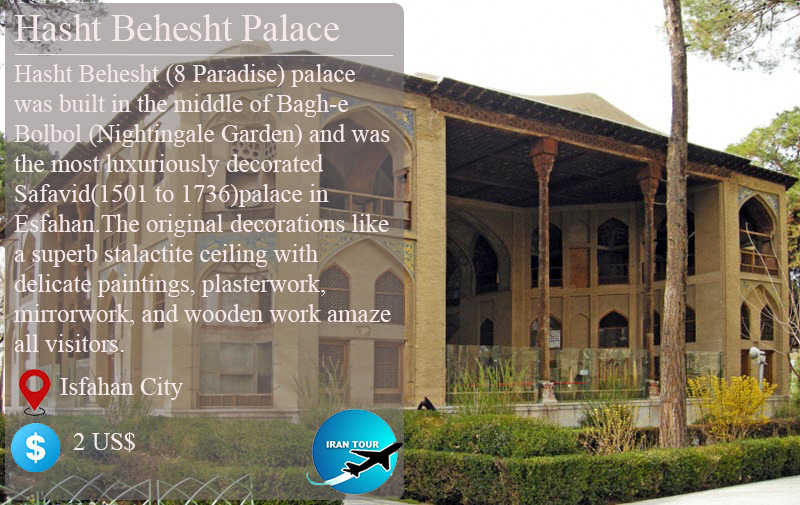 |
At the back of the Abbasi Hotel and next to Art Passage, laid one of the most fascinating palaces of the Safavid era. This palace is laid close to Bolbol or Nightingales garden which is remained from the Safavid era. This palace is founded by the order of Shah Sulaiman some twenty years after the Chihil Sutton. 'Hasht Bihisht' translates as 'Eight Paradises'.
Nineteenth-century engravings reveal that the interior had been covered with tiles and wall paintings that have since been removed. Some of the original mirror mosaics
 |
Continue the Walking Tour of Esfahan with Chehel Sotun Palace
we continue to visit the most beautiful palace of the Safavid era. Chehelsotoon or 40 Columns is located west of Imam Square and south of Sepah Street. This Royal Palace is out of the Imam Square area, but a short distance from it. When you arrive at the garden will see the 20 pillars of the magnificent portico of the palace and its reflection in the water, which change it to 40 columns. Such reflection can only be seen in the morning as the building looks at the East. Besides, forty is the number of abundance in Iranian culture. Chehel Sotun is inlaid in one of the beautiful Persian gardens with tall and lush trees.
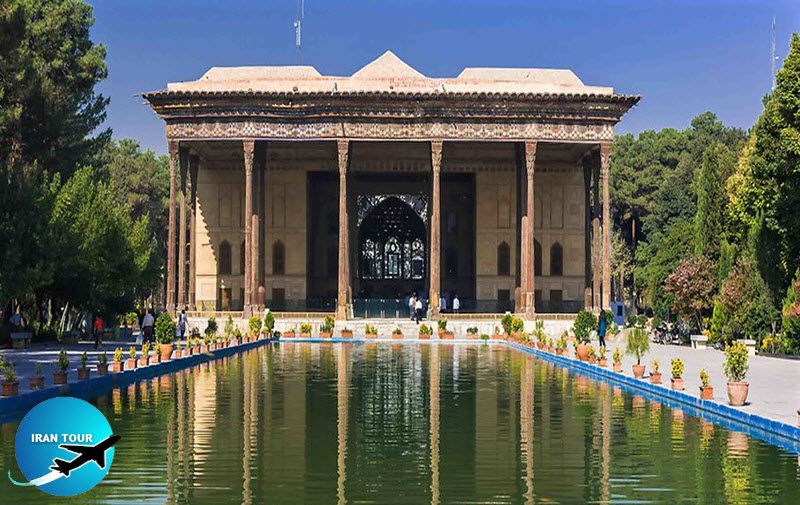 |
This palace is made by the order of Shah Abbas II around the middle of the 17th century as his office to meet the people and foreign ambassadors. This magnificent palace has different halls and rooms for visiting but probably the most outstanding decoration you will see at this palace will be the six huge mural paintings inside showing how Safavid kings protected their power and received other kings and governors. On the lower parts of the walls, there can be watched a series of Iranian miniature paintings depicting mostly courtiers, kings, and nobles having a drinking party inside Persian gardens. On the exterior sides of the palace and close to the back of it, you will see the
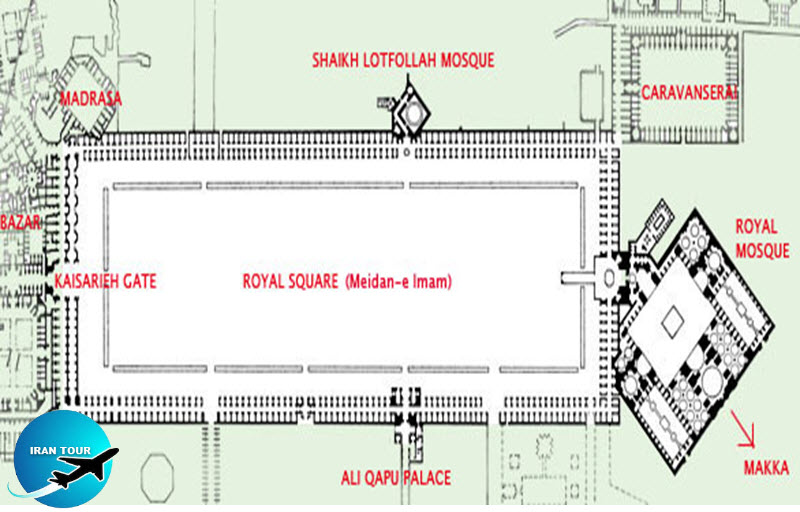 |
Proceed to Isfahan’s Imam Khomeini Square
There’s just a small park distance between the Chehel Sotoon and Naghsh e Jahan Square. You cross this area in less than 5 minutes and find yourself in an overwhelming large square. It is decorated with hundreds of shops on the first floor and nice arches on the second floor from the 17th century. Shah Abbas I, who moved the Safavids’ capital city from Qazvin to Isfahan, started this royal project on virgin ground. This 160 by 500 meters open space was the showcase of the king’s flourishing economy and dedication to Shiite Islam. This sq is decorated with three magnificent buildings, Jame Abbasi or Imam Khomeini Mosque Sheikh Lotfollah Mosque, and Aliqapoo Palace. These magnificent buildings have been completed not once, but all of them started to be constructed more or less around the beginning of the 17th century.
Today, UNESCO recognizes this square as a World Heritage Site and the absolute majority of international travelers love to visit it time and again. It’s beautiful in the morning, but many also love it in the evening with illumination around the monument as well as shops’ window lights.
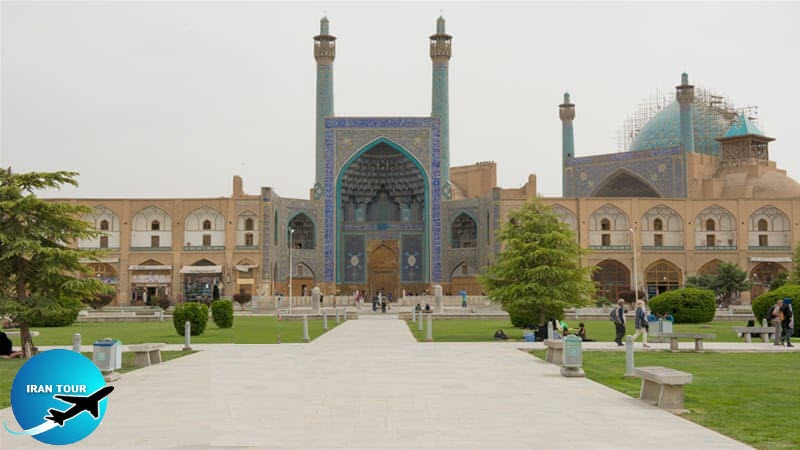 |
Imam Mosque
Imam Khomeini Mosque (World Heritage Site) is located in the Southern part of the square. Although Esfahan had its own Friday mosque Shah Abbas decided to build his royal temple here and also complete the decoration of the sq with a big magnificent mosque. This is a breathtaking mosque and Iranian architects have spent the ultimate of their expertise to make it.
The walls of the mosque are covered with the best different Iranian tiles and mosaics as well as exquisite inscriptions are done by Reza Abbasi, the well-known artist of the Safavid era. The spacious courtyard with four Evans leading to roofed areas of the mosque is marvelously decorated inviting visitors to enter and enjoy the serenity of the temple. This is a 4 Ivan mosque with 2 schools at the courtyards of the mosque. It is an excellent example of the Islamic architecture of Iran and is regarded as one of the masterpieces of Persian Architecture.
 |
Next Is Sheikh Lotfollah Mosque or the private mosque of the Royal Family
we have two unique monuments in front of each other at Naghsh e Jahan Square. Ali Ghapoo Palace and Sheikh Lotfolah mosque were both of them made by the order of Shah Abbass. These two buildings shine like jewels in the square and have doubled their beauty. we have two unique monuments in front of each other at Naghsh e Jahan Square. Ali Ghapoo Palace and Sheikh Lotfolah mosque were both of them made by the order of Shah Abbass. These two buildings shine like jewels in the square and have doubled their beauty.
Ali Ghapoo was the Royal Palace so they made a Royal mosque for the family. This mosque is different from all Iranian and Islamic mosques. It has no yard and minarets and is completely covered by the royal family. This mosque is made for the father-in-law of Shah Abbas I. The fact that it does not have minarets and does not provide a large space for worshipers approves the fact that it was built for use by the royal family members. They could devote their time to the contemplation and worship of God in a quiet and private place. The color of its dome and the beautiful mosaic inscriptions, the exclusive motifs, and the interior decoration style have all contributed to the originality of this mosque.
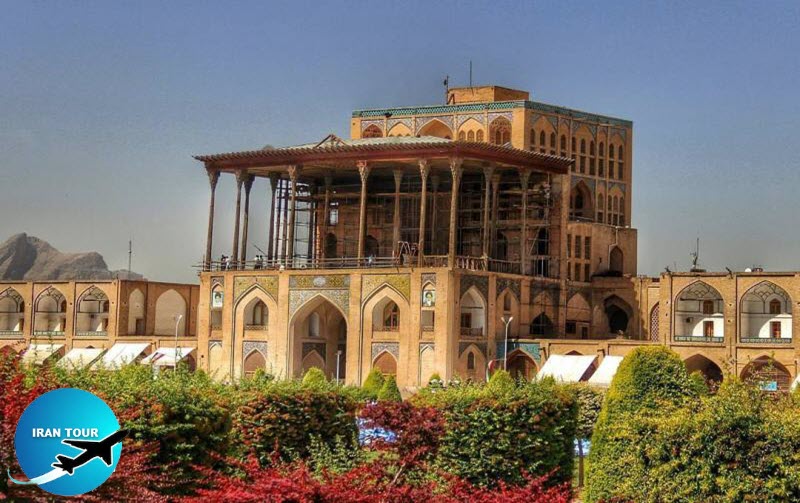 |
Alighapoo Great and beautiful Palace
A 400-year-old building(16th century) without a steel structure was the residence and office of Shah Abbas I. The tallest building in the square with a portico overlooking the square is Aliqapoo Palace. A building with different architecture and beautiful decorations, which is decorated by the best artists of that time. The front of the building has 2 floors with a lofty porch, but in fact, it is a 6 floors building.
Why visit Ali Ghapoo Palace?
- One of the most beautiful monuments of the Safavid period.
- It is located in the historical and global complex of Naghsh e Jahan Sq
- It has unique miniatures and plasterwork.
- Its music room on the sixth floor is a masterpiece of architecture and decoration.
- It has an interesting perspective on Naghsh e Jahan Sq.
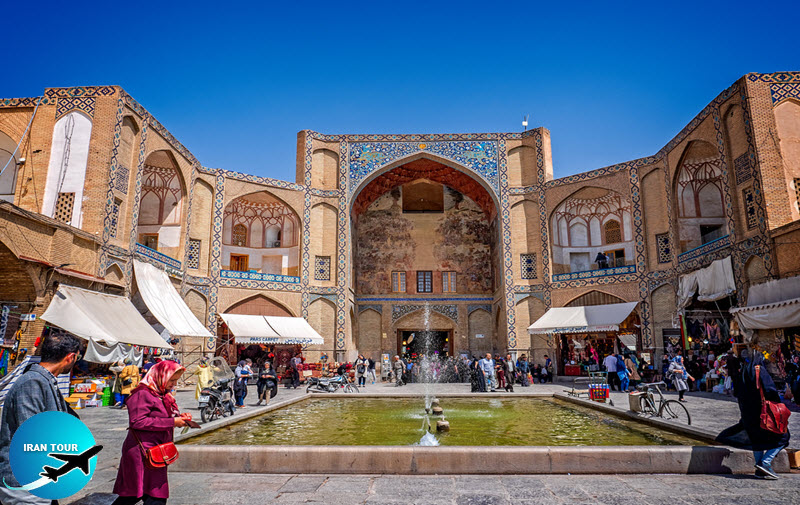 |
Qeysarie Bazar
The last part of this square is Qeysarie Bazar or Soltani Bazaar (Royal Bazar) belongs to the 17th century and is located at the northern end of Naghsh-e Jahan Square and in front of Imam Mosque. The entrance of this Bazar is decorated with different blue tiles, paintings, arches, and a room by the name ”Nagharehkhaneh”, where music would be played at sunrise and sunset. This Bazaar connects the old square (Atigh Square) to the new one which is the Naghsh-e Jahan Square and works as a transition element, built for the development of trading and acceleration of economic growth.
This Bazar has its own traditional and historic style with its old shops having an architectural significance. we can easily call it the most beautiful bazaar in Iran, because of the abundance of craft stores and workshops. You can see different types of crafts and how they are made by craftsmen. When to visit the Qeysarie Gate You can visit Naqsh-e Jahan Square and Qeysarie Gate at any time. It is thought that the most beautiful sites are in the evening, just before sunset, when the sun caresses the domes of mosques. If you wish to visit the Ali Qapu Palace, plan your visit between 9:00 a.m. and 6:30 p.m. The opening hours of the mosques are based on the prayer schedule and differ from season to season.
Lunchtime is now
On this half-day tour, you will visit the magnificent historical sites of Naghsh e Jahan Square and around. It's time to dine and you can select one of the restaurants inside the square or choose other choices outside. Most stores will close down in the middle of the day and it will not be very helpful to spend your time there during nap time. Thus, you may prefer to rest or participate in other activities. Later in the day, you can come back to the square and explore its workshops, craft shops, etc.
 |
To recognize a country, one should taste it.
Traditional, National, and Local Foods on an Esfahani Table
In the local restaurants of Esfahan, a wide range of Iranian foods consists of various fish and meat dishes. Tout, salmon, etc 8 grilled boiled. Accompaniments, such as French fries, tomatoes, pickles, vegetables, and onion (spring) are added to complement the delicious foods. The main people sprinkle some sumac or lime over their main courses, especially di different types of kababs, for better taste and to aid digestion. On the
Among the existing stews (Khoresht), one of them, which is very nice, especially for foreigners, is called, "Khoresht-e-Fesenjan' its ingredients are:
Pomegranate sauce, walnuts, chicken, duck, or mutton in the northern part of Iran is locally called; Mutoon Jan). Another famous Iranian dish is "Khoresht-e-Qeimeh' which contains: Meat, split peas, lime, tomato sauce, and onion served with plain rice. Qormeh Sabzi is also another choice cooked with tiny pieces of meat, beans, onions, lime, and green leafy vegetables. "Khoreshte Bademjan', eggplant stew, includes: eggplants, meat, tomato sauce, onion, and spices
"Khoresht-e-Beh', quince stew, is cooked with quince, meat, tomato sauce, onion, etc. There are many other different Iranian dishes to try, so for further ideas, refer to the cookbooks.
The drinks consist of mineral water doogh (diluted yogurt, a national drink made from yogurt, dried mint, and water), and the different kinds of donated soft drinks. Tea or coffee, upon request, is also served after every or dinner to top off a wonderfully delicious meal.
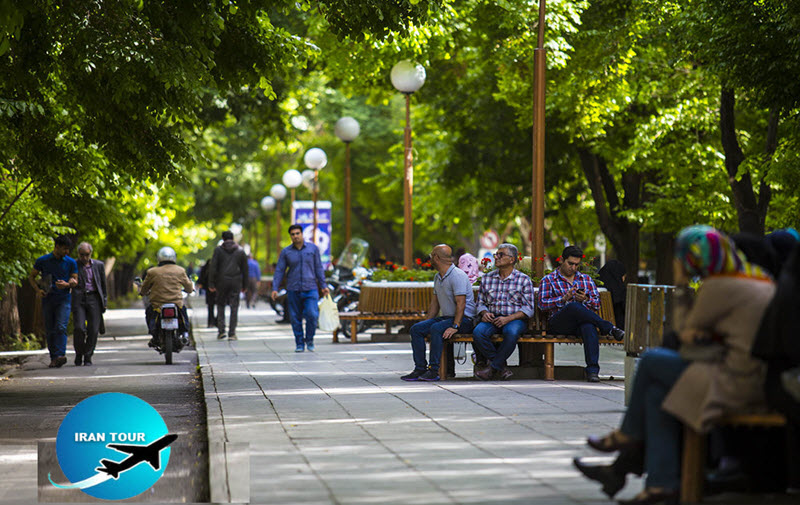 |
Pm: Hiking in Chahar Bagh street
After lunch in the restaurants of Isfahan to reach the next destination Walk on the historic street Chahar Bagh will be one of the parts of your one-day tour. A beautiful, broad, tree-lined boulevard that stretches from the west of Naqsh e Jahan Square beyond Isfahan Palace to Si-o-Seh Pol leading south to the Armenian neighborhood of Jolfa also connects the South and North of Isfahan each other It is today the main pedestrian and vehicular artery of the city. The avenue serves as a reference for all the other streets of Isfahan - east, west, north, and south - all roads lead to Chahar Bagh.
The name literally means "four gardens" - a typology of landscaping based on cruciform mandala plans, incorporating elements of the land and sky, through the use of green spaces, a body of water central, and bisection trails. The treatment of the boulevard itself is consistent with this ideology: beautifully landscaped, with seating and seating areas, occasional water bodies, and public walkways, the Avenue presents a rich and interactive urban landscape for residents of the city.
You can visit the mosque and the theological school of Chahar Bagh which is the pinnacle of elegance in mosaic architecture and the old ditches(Madi) while you are walking on this route will lead you to the historic bridges of Isfahan.
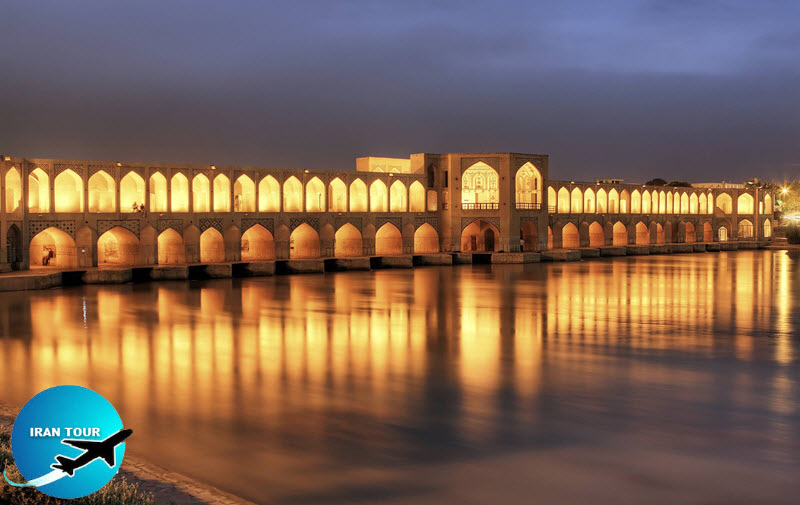 |
A Memorable sunset on Zayande Rood River and its historical bridges
The total length of Zayandeh Rood is about 420 kilometers (one of Iran's Rafting rivers) which finally leads to the Gav Khuni Marsh. Since the time of the Sassanids to the present, some bridges and dams built over the river, so the banks of the river have been always an unparalleled host to people. At the western extreme of the city, there
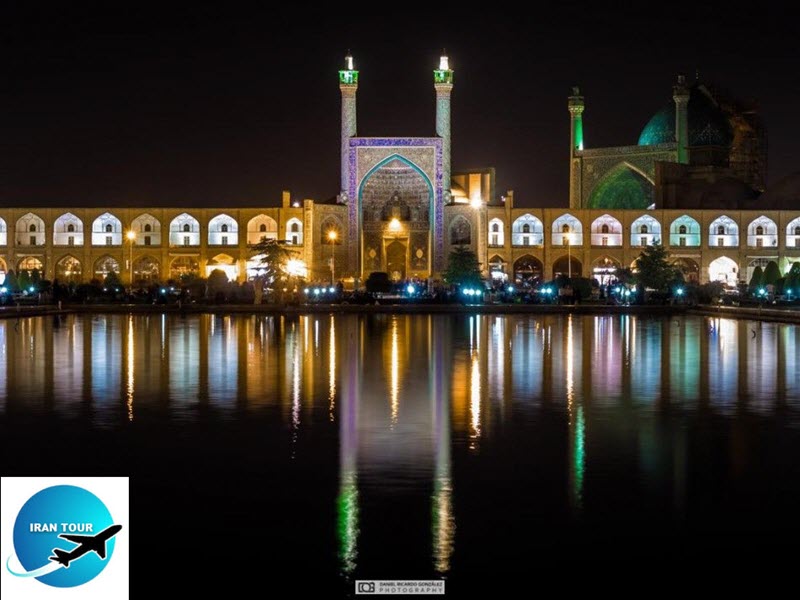 |
Night
Naghsh e Jahan at night
After a day tour, Isfahan's night beauties will be the last part of your trip. After watching the sunset on the bank of the Zayandeh Rood River, Naghsh e Jahan sq will be the last place that you will see at night.
Spending time in Naqsh-e Jahan Square is a must.
This is a beautiful place not only during the day but also in the afternoon and evening when people gather to watch the sunset. The Royal Palace and mosques are shining, many people take the opportunity to have a picnic on the lawn around the pool and fountain. You can hike around and talk with people and be sure hospitable people will invite you to a cup of tea or dinner.
 |
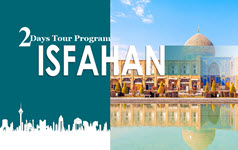 |
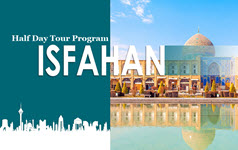 |
- Details
- Category: Esfahan Tourism













